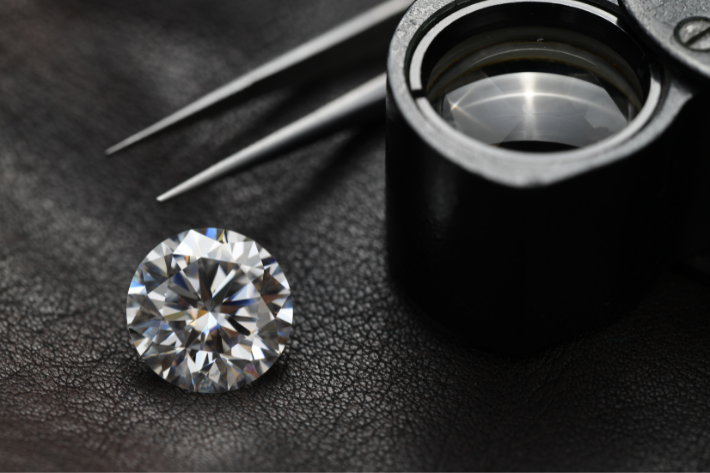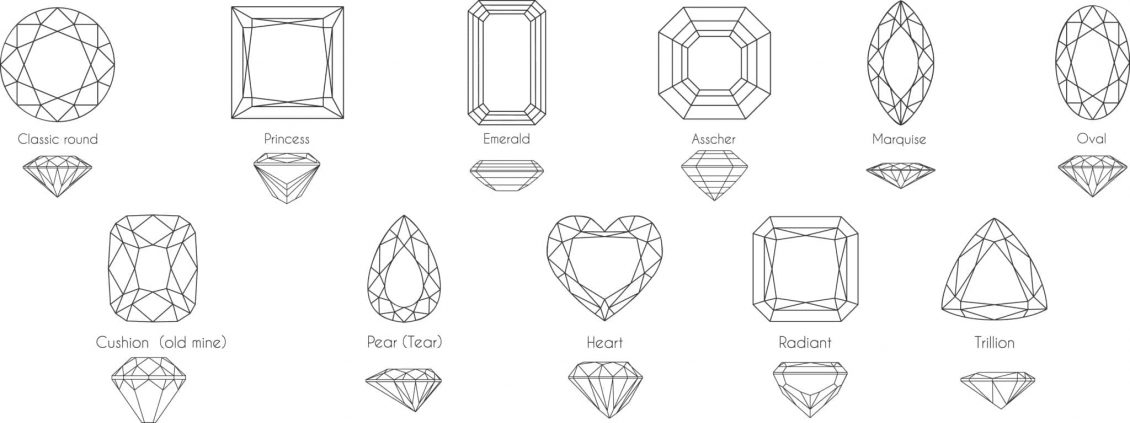Diamond Buying Guide

Buying the Perfect Diamond for your Special Someone
Popping the question is no small feat and this Diamond Buying Guide is here to make your life easier! In fact, it is a process that has many people shaking in fear and producing tons of questions. What kind of diamond should I get? Will they love their ring? How can I make this special for the one I love?
We’ve hear these questions before, and we promise to make the ring-buying process as smooth as possible. Our diamond buying guide below is here to help educate you on the 4 C’s of diamond buying and why they are an important part of your purchase!
COLOR
Diamond color is actually graded on lack of color. The best fine diamond jewelry contains stones that are almost clear. The hues graded in “white” diamonds are faint yellow, brown, and grey tones. An alphabetical scale from D through Z is used to rank the color. Imagine two glasses of water — one clear, the other containing a few drops of lemonade — and you will begin to understand the differences in diamond color grades.
Once the color saturation moves beyond Z or has a different hue than yellow, brown, or grey, the gem becomes a fancy-color diamond. Fancy colors are graded on how much color the diamond has and how strong the hue is. Diamonds come in every rainbow color, including blue, pink, yellow, purple, and black. In general, fancy diamonds are rarer than white diamonds.
The following color scale is an approximate representation of color saturation in diamonds (click to enlarge):

- COLOR. CLARITY. CARAT WEIGHT.
For a first-time buyer, you might as well add Complicated to that list. Don’t worry. With the help of our comprehensive Diamond Buying Guide, we’ve got you covered. Rest assured, beautiful diamonds can fit almost any budget. Plus, by knowing a thing or two about the 4Cs, you can shop smarter and most likely score a better value.
CUT
Cut is divided into shape, proportion, polish, and symmetry. Shape and proportion are all of the great importance when cutting a diamond to its best appearance. Shape and proportion determine how a diamond scintillates because it affects how light is reflected and refracted inside the stone, which is what causes diamonds to sparkle. Depending on how deep or shallow the diamond is cut, the face-up appearance of the diamond can also vary greatly. The polish describes how well light enters and exits the facets of the diamond. Symmetry can describe both length-to-width ratio and also depth percentages.

CLARITY
Clarity describes the inclusions and blemishes of a diamond. The fewer inclusions and blemishes a diamond has, the more valuable it is. Clarity can also directly impact the stone’s brilliance: Inclusions in the diamond can block the light from reflecting inside the stone, which is the feature that gives diamond jewelry its fiery beauty. The following diamond clarity grades are listed from best to least and are based on the observations of trained gemologists (click image to enlarge):

CARAT WEIGHT
Carat is a weight measurement of diamonds. It is abbreviated “ct” or “CT” when describing a single stone. “CTW,” meaning “carat total weight,” is added when the diamond jewelry is set with multiple diamonds. For example, a solitaire diamond engagement ring may be described as 1ct, while a three-stone diamond anniversary ring would be 1 ctw.
Carat vs. karat: Carat is not the measure of gold’s purity, which is spelled “karat” and is abbreviated “k.” For example, you may have a 1-carat diamond in an 18-karat gold setting.
This chart shows how the sizes compare to each other, but this is not a representation of the actual size of diamonds (click to enlarge):

SHAPE
Jewelers use a standardized set of shapes as patterns for cutting stones. The shapes with more facets, like the 58-facet round brilliant, have the most sparkle. However, the shapes with fewer facets, especially the emerald, better showcase the color and clarity of higher-quality diamonds. The shape is especially important in diamond rings. The princess, heart, and round shapes flatter delicate fingers, long or short, and the longer shapes, such as marquise, pear, and emerald, elongate the finger.

CERTIFICATION
A diamond certificate is an evaluation by a third party, not by either the diamond buyer or seller. Unfortunately, a 3rd party certification isn’t necessary, as it would be easy for an unscrupulous jeweler to take advantage of an uninformed buyer and sell him or her a stone, which ostensibly has much better characteristics than it really does.
There are a number of ways unsuspecting buyers might land a bad deal. If the diamond is not certified, there is a good chance you may be buying a stone that is one or more grades below stated values in terms of carat weight, color, clarity, cut or whether or not it has been “enhanced”. Without a certificate issued by a reputable agency, such as GIA, AGS, a buyer relies on a jeweler’s integrity that the diamond’s 4C parameters are accurate and not overstated.
Not all laboratories are created equal. GIA is the best diamond grading laboratory in the world due to its reliable and stringent grading standards and its undisputed grading reports. Their dominance in the industry is due to their consistency in that they can consistently assign similar diamonds to the same grade. Unlike some other labs, GIA is not owned or partially owned by diamond wholesalers or retailers. It is a non-profit organization. GIA actually developed the “4 C’s” diamond grading system (used almost universally today) to provide truly objective standards in evaluating a diamond.
Looking for the Perfect Diamond?
GIA
The Gemological Institute of America (GIA), is the leading gemological laboratory in the world. It is the industry’s most trusted and widely used service. Headquartered in Carlsbad, California, GIA has offices in many cities worldwide, employing more than 1400 scientists, educators, and certified diamond graders.
Besides gem grading and certification, GIA also provides educational services and conducts intensive research to keep up with fast-changing technologies in the gemological field.
Information Provided by GIA
- Categories:
